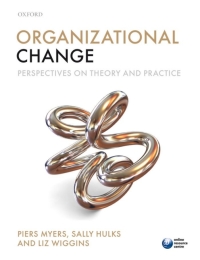The National Trust is a UK charity that looks after 350 historic properties, 700 miles of coastline,
Question:
The National Trust is a UK charity that looks after 350 historic properties, 700 miles of coastline, 600,000 acres of countryside, and has an annual turnover of £400 million. It employs 5,800 people. The original organizational purpose of conserving the past remains, but engaging visitors is now equally important. This means allowing visitors to handle certain objects, to experience playing billiards ,or to dress up in eighteenth-century costumes. It also means attracting a more diverse range of visitors. These changes are not being welcomed by all of the 55,000 volunteers who are essential to the functioning of the Trust and tend to be retired, middle-class people who work unpaid as tour guides and car park attendants.
‘The Trust has come to be seen as something for the middle class. We want to embrace a wider sweep of society’, said Simon Murray, a member of the senior management team (Financial Times, 2010). Another member of the senior management team said that the Trust is undergoing a cultural revolution and no longer wants to be seen as ‘some sort of exclusive club for connoisseurs’ (The Guardian, 2010). It is no longer just interested in stately homes, and recently bought Paul McCartney’s house and Victorian workers cottages in the centre of Birmingham.
The role of the nine regional directors has become far more external facing, to attract new types of visitor, rather than just overseeing the properties in their region with the existing visitor profi le.
Following the redefi ning of their roles, all were asked to reapply for their jobs, but only a handful were successful, which sent shock waves through the organization. The forty most complex and highpriority properties are now run by newly titled ‘general managers’, many of whom were new to the Trust and had a business background. As part of the change to create a nimbler and more responsive organization, which meets the corporate goal of visitor enjoyment as much as conservation, general managers have been given more responsibility and accountability. This means that they have the authority to make decisions they believe to be in the best interest of their property. Before, decisionmaking, and therefore power, lay much more with the Trust’s technical experts, whose areas of specialization range from archaeology and painting conservation, to landscape gardening, building maintenance, and land management. The technical experts have therefore needed to make a shift in their role, behaviour, and skill set, to become internal consultants who now need to regard the general managers as clients.
So the change in National Trust strategy has meant signifi cant changes to the roles of many people within the organization.
Questions 1. What events serve to indicate to employees the scope and scale of the change being initiated by the leaders on the senior management team?
2. If you were the change agent, implementing this strategic change on behalf of the senior management team, what could you imagine yourself doing to fulfi l the control agenda and the process agenda? What type of experience would be useful for managing the content agenda?
3. Using Kellerman’s (2007) typology of followers, imagine how employees and the 55,000 volunters may respond if asked to describe the change programme.
4. How might the descriptions of consulting roles help the technical experts to understand their new roles as internal consultants?
Step by Step Answer:

Organizational Change Perspectives On Theory And Practice
ISBN: 9780199573783,9780191512902
1st Edition
Authors: Piers Myers; Sally Hulks; Liz Wiggins





